This Head, This Body
Viktor Orbán's dance with modern politics
Ana Isabel Keilson
Once, all our bodies were the body of the king. Six hundred years ago, kings had two bodies, one natural and one politic, and the corpus mysticum of their lands was made of “organological aspects: a body composed of head and members.”[1] Louis XIV, the Sun King, inherited two bodies, but he made them different—he made them dance. Throwing back his heavy robes, this king revealed his absolute power with his shapely legs, and he did it by inventing dancing as we now know it: onstage, in front of others, a skilled body moves. He trained his body—pointed his feet outward and opened his hips suggestively—and the diagonal vectors of his lines and limbs created the illusion of infinite command. Coordinating arms and legs into harmony, he showed himself as the master of his body and the master of those incorporated into him. Dazzled by the dance, we watched his fingers and lost our point of reference. His body, which we belonged to, became the world all around. There was no head but his, no body but the one he had made. This body, moving effortlessly, seemed natural but wasn’t.
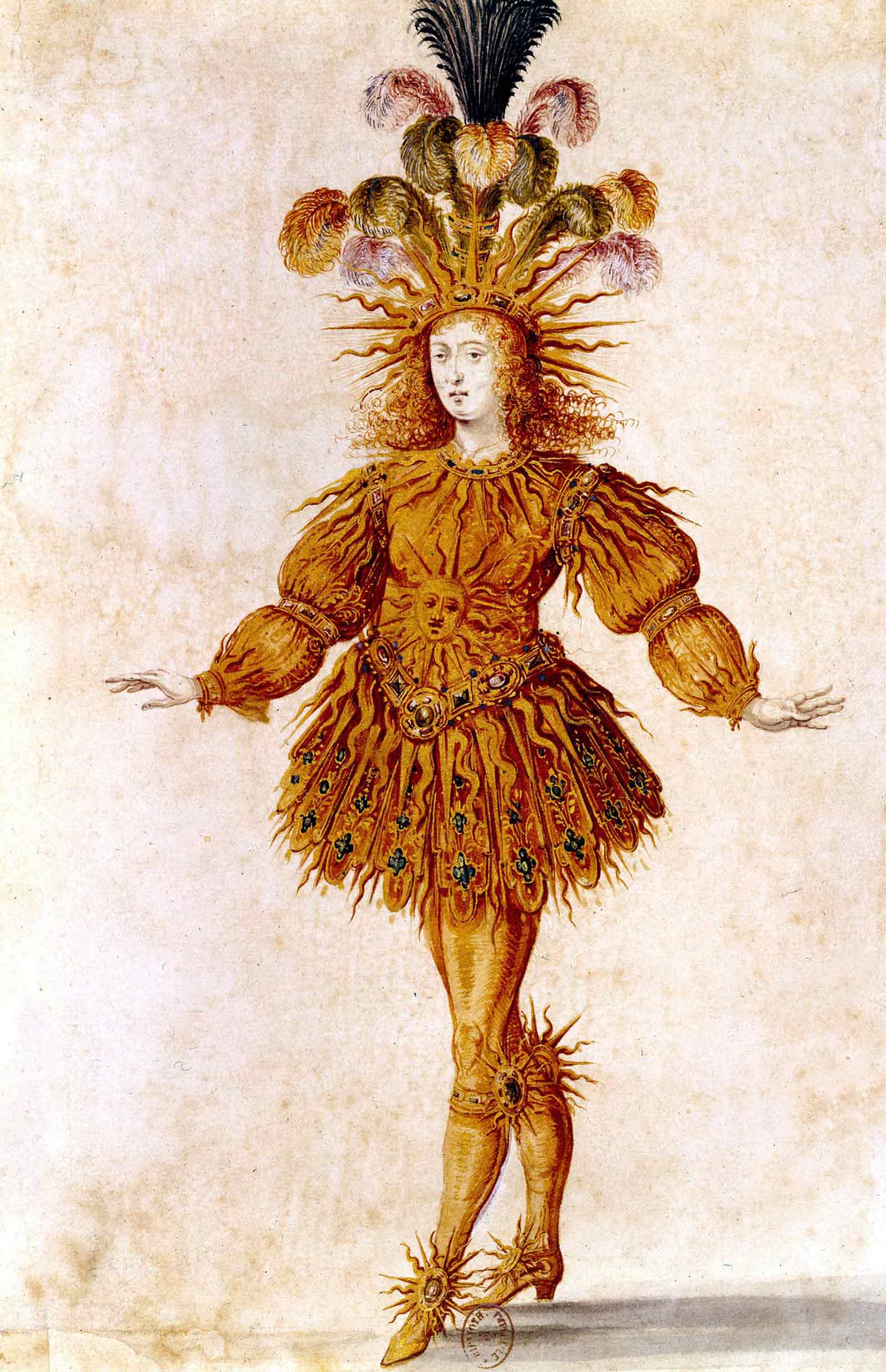
Around this time in another country there appeared a different dream of sovereign power. In this dream, all our bodies were part of the leviathan, a great monster made of all of us. Our bodies were its body, and it moved because we moved. Thomas Hobbes, witness to the English civil war, invented with this dream politics as we would later come to know it: power was no the longer divine right of kings, but an invented calculus of movement among individuals seeking freedom from restraint and the security of their own bodies. This body, the nightmare of Christian kings, swallowed all bodies into one, caging nature through invention. Our movements authorized this giant body unnatural as sovereign; if we agreed to its terms, it would protect us from the war of all against all and the disorder of men unable, or unwilling, to master themselves. We would spur it into motion, and we would feel its dance, however terrible, as ours.
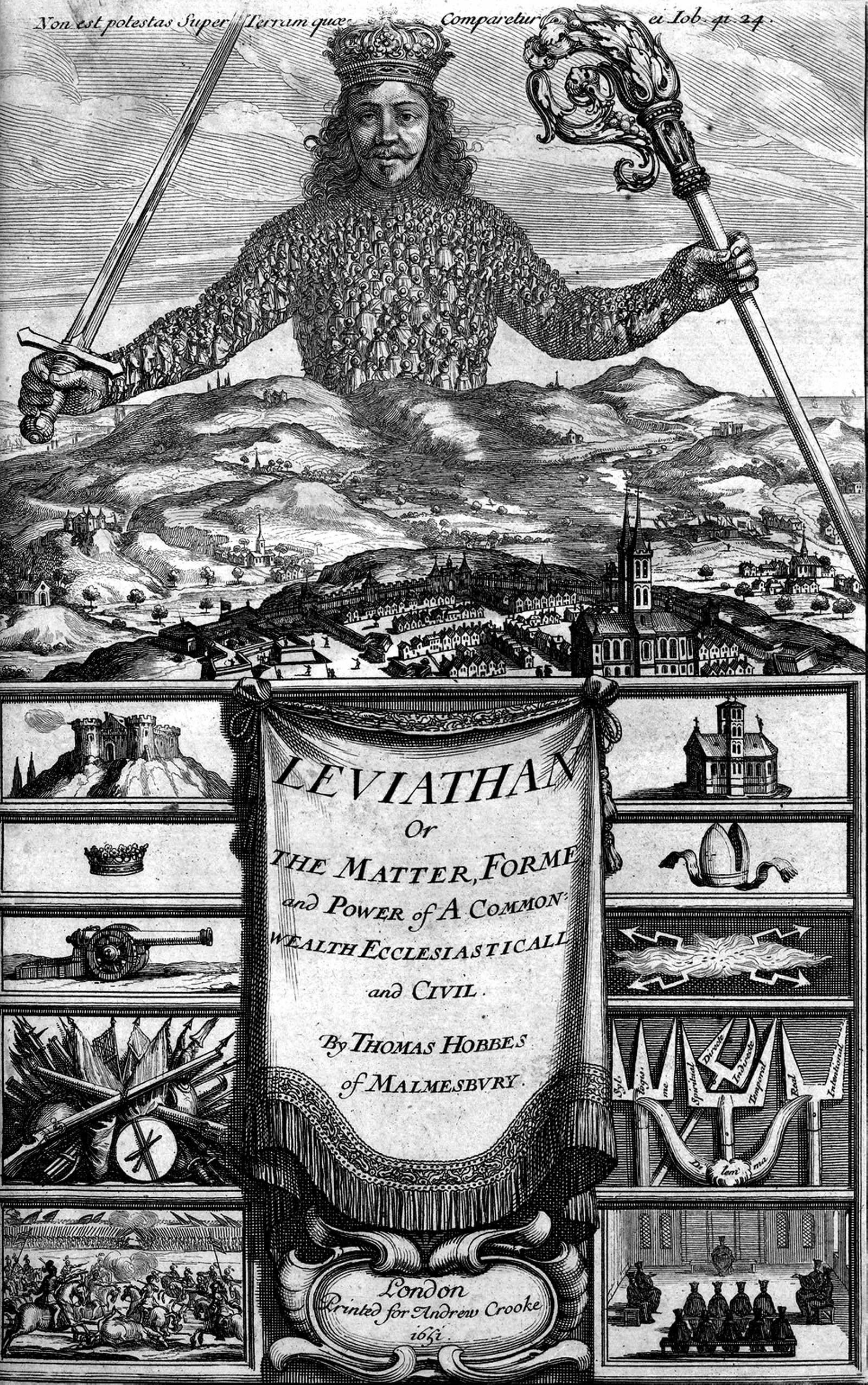
A little more than a century later, revolutions happened. Powers separated and republics declared. We dumped tea in the ocean, demanded proximity and representation. We killed the king and cut off his head. We said, this head is not our head! Our natural bodies, protected by natural rights, had won. We celebrated in style, with pomp and circumstance. We felt, in our collective steps, our body politic as a part of something that no single body could master—democracy, republicanism, freedom. Our heads were ours to believe with, our legs and limbs ours to move. The power we rallied and the spectacles we made were magnificent. We assembled ourselves as citizens and people, no longer mere bodies.
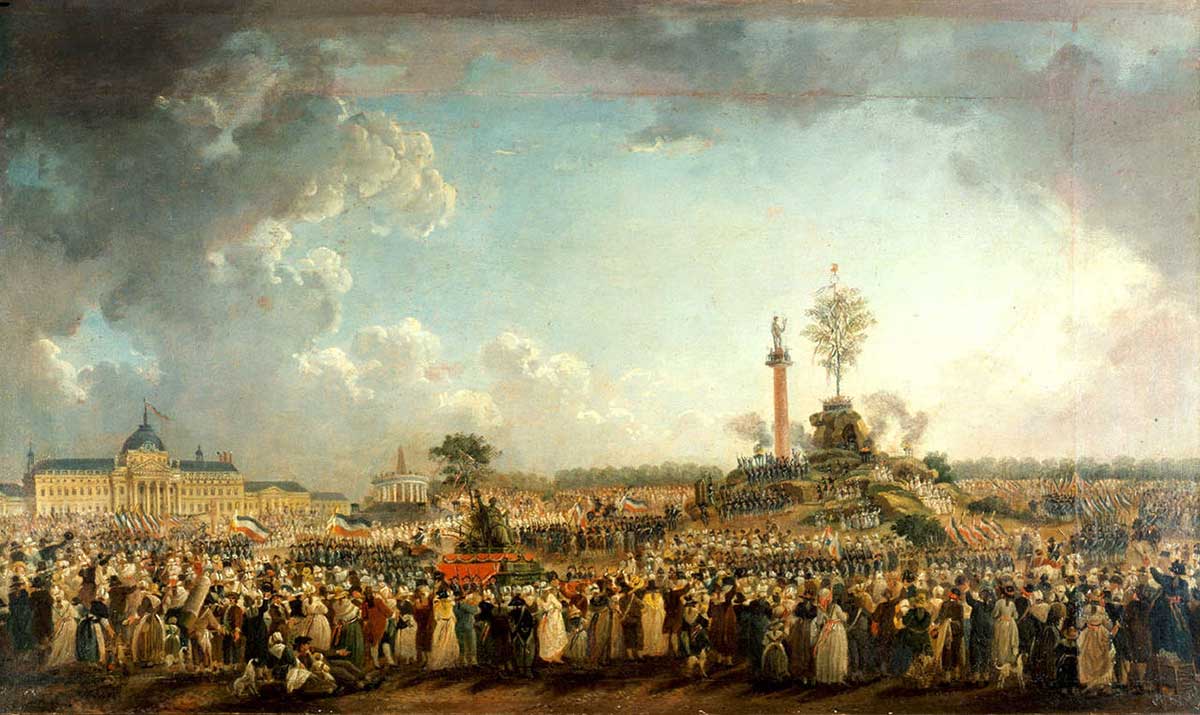
Meanwhile, another revolution gained steam. Behind the backs of the revolutionaries, the market emerged. It moved with an invisible body and invisible hands. It toyed with pins and needles, trucked and bartered between us. It divided labor. It opened factories. Our bodies became things to buy and sell—and to be bought and sold; our bodies became things to circulate. Years passed. Governments secured us with schools, hospitals, prisons. Our bodies had insides and outsides, to be opened and closed at will. We trained, we worked, we became the masters of ourselves. We elected heads of state to be our heads. We expressed outwardly what we felt to be true in our private hearts and minds. We danced with bare arms and feet, affirming mastery over our newly composed, strong, skillful selves. The forces that moved behind our backs—history, economy, society—became partners to dance with. And the things we could not control or did not understand we left up to chance, taking comfort and pleasure in the mastery of our own moving bodies.
• • •
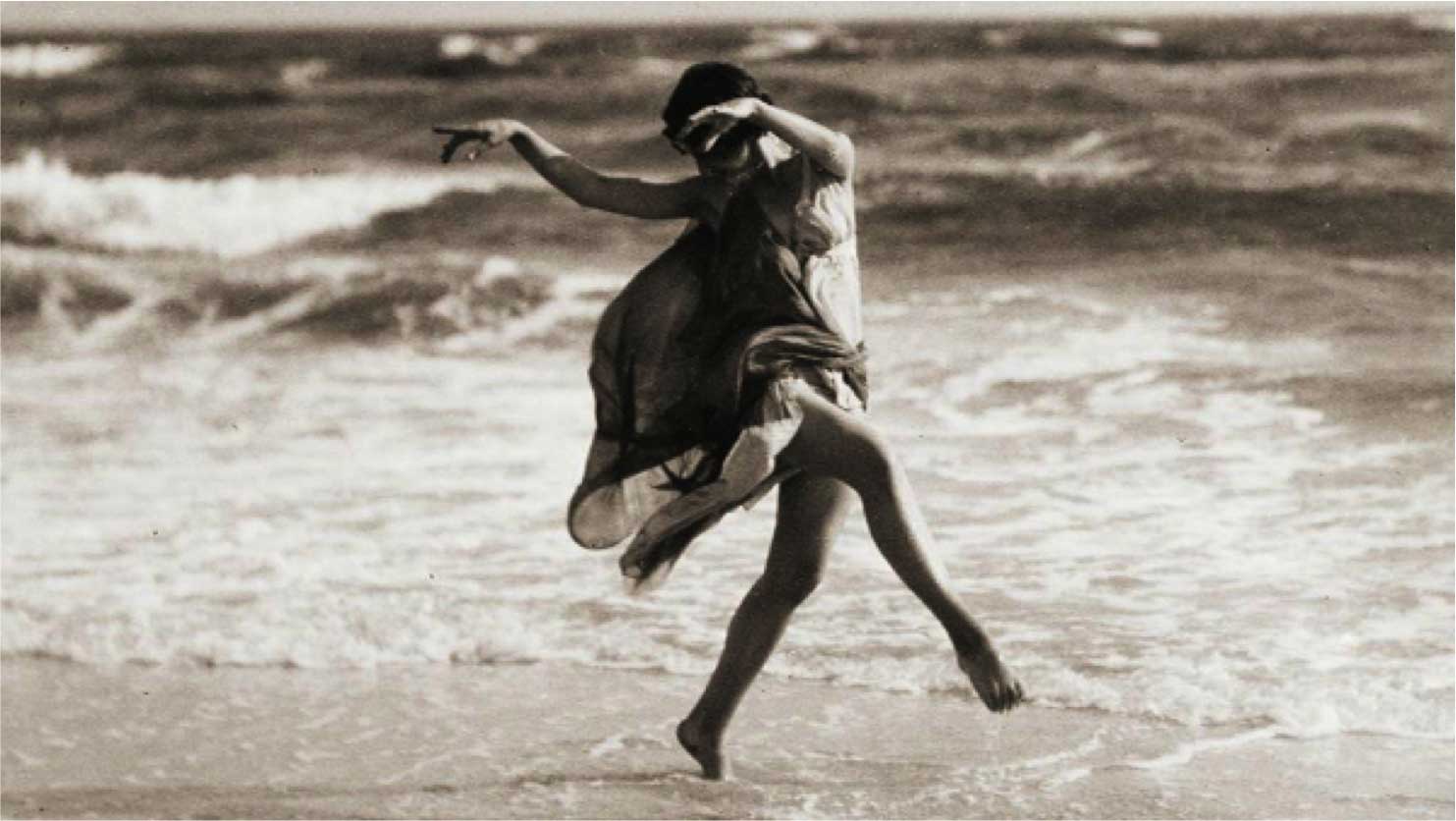
On April 30, 2020, Zsolt Kovács, a Hungarian ballet dancer, leapt across the front page of the Financial Times. “Out of Step,” the FT headline read. “Hungary stirs freedom fears.” Kovács, wearing all black—mask, shirt, jeans, gloves, sneakers – danced in an empty Heroes’ Square in Budapest to a musical score by M.I.T. scientist Markus J. Buehler, who used the molecular structure of COVID-19 as the basis for his composition “Viral Counterpoint of the Coronavirus Spike Protein (2019-nCov).”[2] Kovács, a member of the Lithuanian National Ballet, had returned home to Budapest to wait out the lockdown. Inspired by Buehler’s score and motivated by the “melancholy” he felt surrounding the pandemic, Kovács combined a repertoire of standard classical steps with personal flair—hip undulations, hand swipes, emotive affect—showcasing his athleticism and virtuosity.[3]
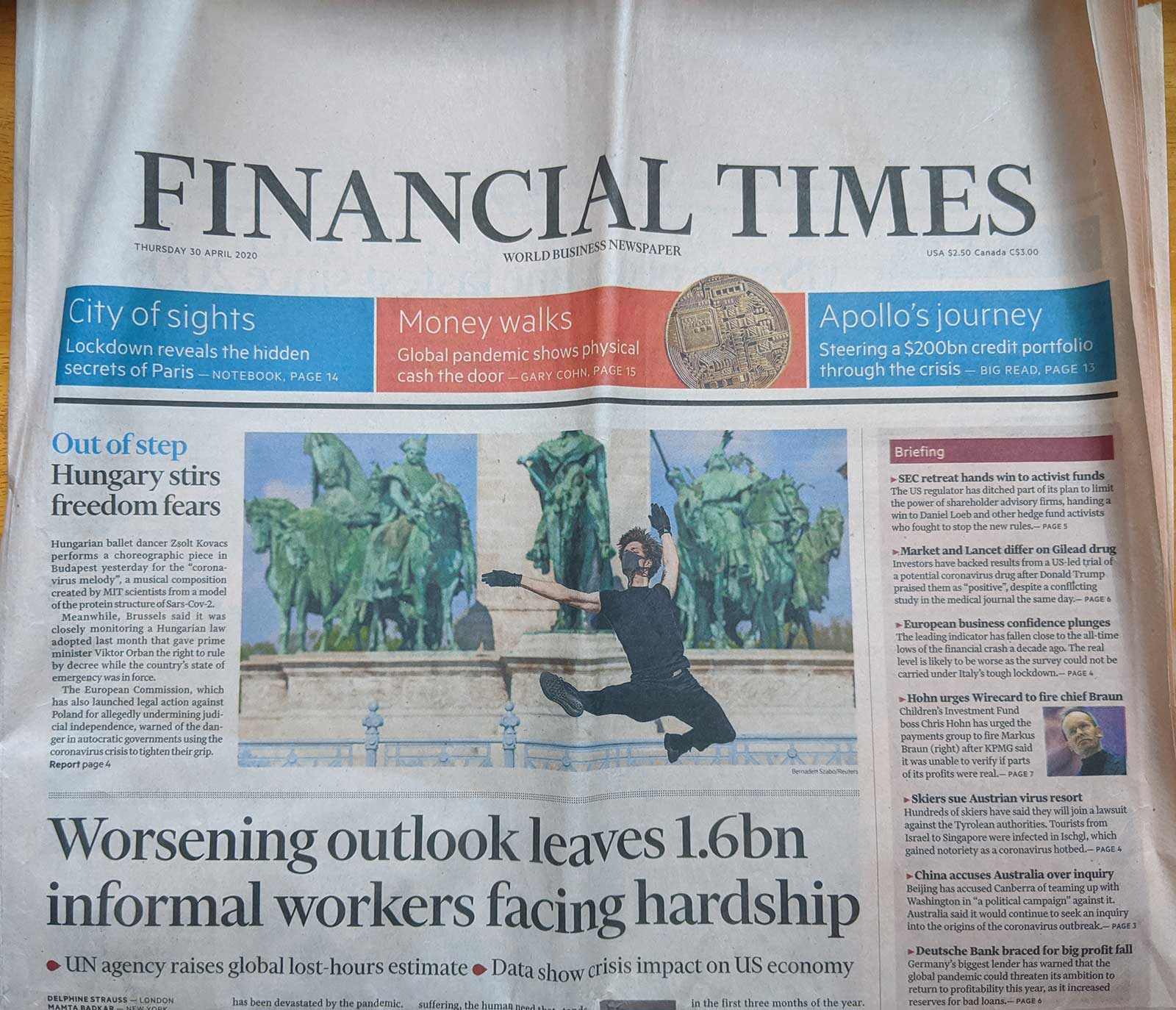
One month earlier, Hungary had indeed stirred freedom fears. At the beginning of March, its government, led by prime minister Viktor Orbán, announced a state of emergency in response to the coronavirus pandemic. Several weeks later, on March 30, the Hungarian parliament passed a bill granting Orbán unlimited emergency powers without a clear end date. This enabled him to rule indefinitely by decree. Additional measures included in the bill were possible prison sentences for up to five years for journalists charged with spreading misinformation about the virus, underreported in Hungary—another step in a set of measures that have over the years gradually eroded independent media.
As many observers have pointed out, Orbán’s emergency decree was altogether not surprising. Since 2010, when Fidesz, Orbán’s political party, won a parliamentary supermajority, he has been steadily centralizing power through constitutional, legislative, and judiciary reforms. These have included measures such as amending the constitution, appointing judges, scaling back the number of representatives in parliament, and quelling political and media opposition. For years, Orbán has waged “nothing less than a comprehensive Kulturkampf” within Hungarian society.[4] Directors of schools, theaters, and cultural institutions are government appointed. Orbán has run campaigns to restore “Christian” and “family values” in Hungarian life—granting, for example, loan forgiveness to women who have three children and tax breaks for families with four[5]—and establishing holidays to reinforce nostalgia for the Habsburg Empire. (Shortly after the 2010 election, Orbán declared a “Day of National Unity” commemorating the signing of the Treaty of Trianon, when Hungary suffered substantial territorial losses to the Western Allies after World War I.) Long before his attacks on George Soros, Jean-Claude Juncker, or his draconian anti-immigration policies in light of the 2015 refugee crisis—including a fence along Hungary’s Serbian and Croatian borders—Orbán fueled his speeches with nationalist, anti-EU rhetoric against the liberal West, often in defense of a “true” set of Christian values native to European soil.
For some FT readers, Kovács’s leap is out of step with his government. The dancer’s sharp body soars against the blurred lines of the Seven Chieftains of the Magyars, the statue in the center of Heroes’ Square, which Orbán has reinvented as a symbol of Hungarian nationalism. Here, Kovács is the free individual moving in defiance of his head of state. Kovács’s own biography supports this reading. A member of a foreign ballet company, he crosses borders to create his art and dances a composition of his own making: not a folk dance, which is a transparent invention of national politics, but one inspired by the sounds of scientific research, academic freedom, and global exchange—all values Orbán abhors. Kovács’s personal flair (hair blown in the wind, flourishes in gesture, a necklace with no apparent symbolism) evidences his outward expression of his inner feeling. He is an example of freedom and individuality in the face of indefinite authoritarian lockdown. He is the master of his body; his legs, arms, and head belong to him. Orbán does not own him, cannot hold him back.
In 2014, after Fidesz secured a majority in parliamentary elections, Orbán explained his approach to politics by casting mastery and invention as the heroic couple in a Manichean drama of world history. “Thank you everybody, providence, the voters, the Hungarian lawmakers, and finally those who turned against us and provided the chance for good to win,” Orbán declared. “Because if there is no bad, how could good get mastery over the bad?”[6] Citing FT statistics, he described Hungary’s economic collapse in the 1990s and 2000s as proof of Western liberalism’s failure to deliver on its promise of freedom. Left to our own devices, he asked his audience, how will the weak be protected against the strong? How will the individual feel himself as a part of the community? For Orbán, this pointed to the necessity of a new approach to the body politic, building it from the ground up. “And we will attempt to found the world we can call Hungarian society on this theoretical principle, in political thinking, education, in the way we ourselves behave, in our own examples.”
For other FT readers, like Orbán, Kovács’s dance means something else. Just as the announcement of Orbán’s exceptional powers was not an exceptional event, but merely a new flourish on a power play unfolding for years, the leaping body is not an exceptional body. It is one whose self-mastery mirrors the mastery of its head of state, a leader who skillfully joins parts to the whole, and trains and coordinates them into effortless action. “What is happening today in Hungary,” Orbán explained, “can be interpreted as an attempt of the respective political leadership to harmonize [the] relationship between the interests and achievement of individuals … with [the] interests and achievements of the community, and the nation. Meaning, that [the] Hungarian nation is not a simple sum of individuals, but a community that needs to be organized, strengthened, and developed and in this sense, the new state that we are building is an illiberal state, a non-liberal state.”[7] In Orbán’s Hungary, the freely moving individual still exists, but it is one whose own body—and the social body it belongs to—is built, “strengthened and developed” over time. What is this body Orbán has made? How does it move? How does it behave?
• • •
As observers have pointed out, Orbán was once a liberal.[8] In the mid-1980s, he belonged to a group of youthful anti-communists, activist intellectuals who founded Fidesz as a liberal party—“though more in the European sense, shading into libertarianism”[9]—for youthful bodies (no one over thirty-five allowed). Orbán cut his political teeth speaking out against the rule of distant heads on proximate bodies: he gave his first performance in Heroes’ Square in June of 1989 at the reburial of Imre Nagy, leader of the 1956 Hungarian uprising against Soviet control.[10] Orbán’s anti-Soviet activism attracted the attention of Soros, whose foundation, the Central European Research Group, Orbán worked at and which later sponsored his studies at Oxford. Committed to political action and private gain, he left Oxford after less than a year, returned to Hungary, got elected to parliament. In 1994, Orbán became the head of Fidesz. He steered it right and made it a party of capital profit. Recent investigative reporting in Hungary, for example, has shown how Orbán, his family, and his friends have reaped huge financial rewards from state construction projects, many of them supported by the European Union.[11]
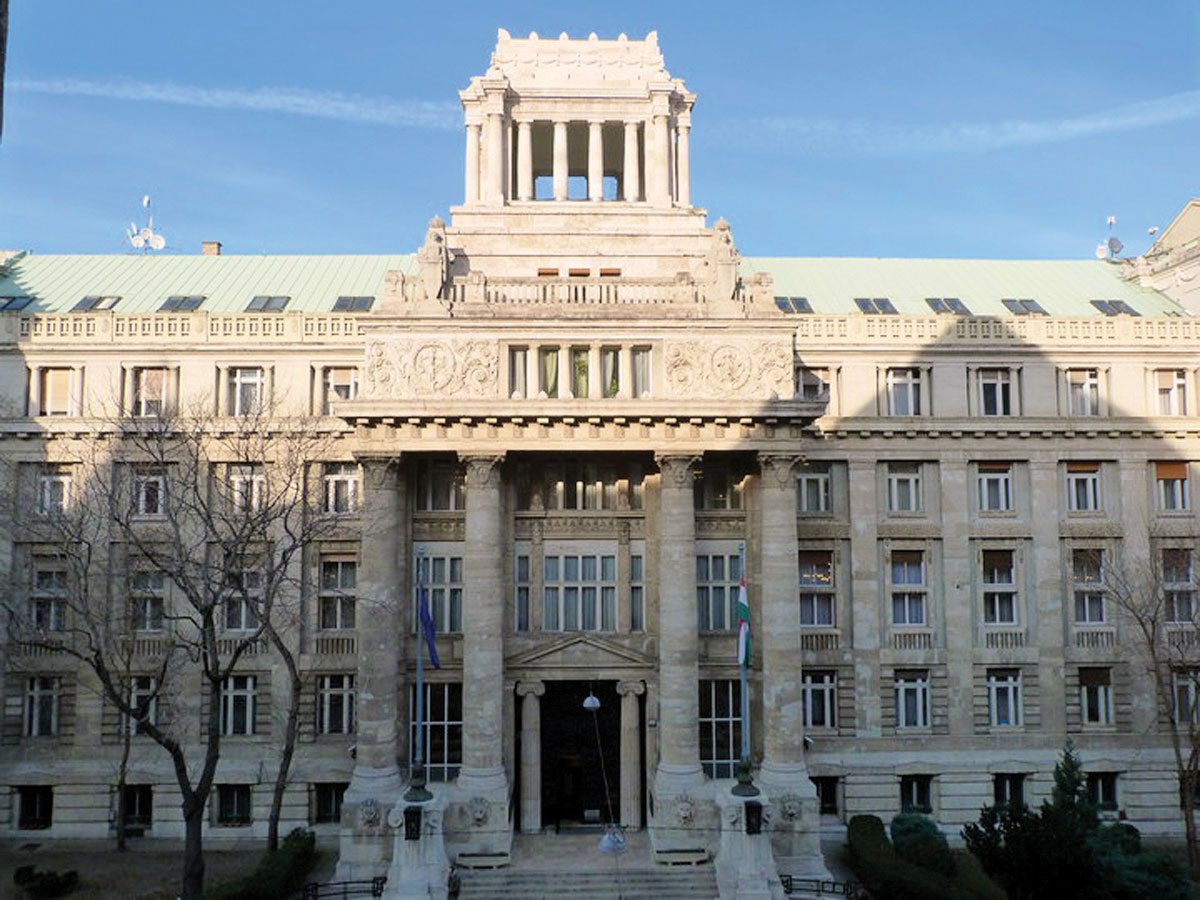
Orbán’s political strategy is known as “the dance of the peacock.”[12] In it, he makes a series of extreme positions, waits for a response, and flatters his opponents by walking back his original stance. Yet in the fluff of feathers, and the slow duration of the exchange, he gains political ground. “His skillful dance moves [consist] in making cosmetic changes in reaction from Brussels—but ultimately persisting with the overall project of centralizing power in his hands,” notes political theorist and historian Jan-Werner Müller.[13] One example of this is Hungary’s court system. Since 2010, Orbán has been packing the courts with loyalist judges, forcing four hundred judges into retirement. Step one. In 2012, this raised the alarm of the European Council’s Venice Commission, which prompted a report by the commission expressing concern for a lack of oversight and abuse of power.[14] Step two: the Hungarian government, in a gesture intended to appease the EC, opened a national inquiry into the practices of Tunde Hando, chief of the Hungarian judiciary.[15] Six years later, in December 2018 and following a third term landslide re-election, Orbán issued a law—step three—establishing a separate administrative court system, controlled by the executive branch, charged with overseeing issues such as asylum cases, police violence, the right to assembly, and elections. With Brussels watching, the curtain closed.
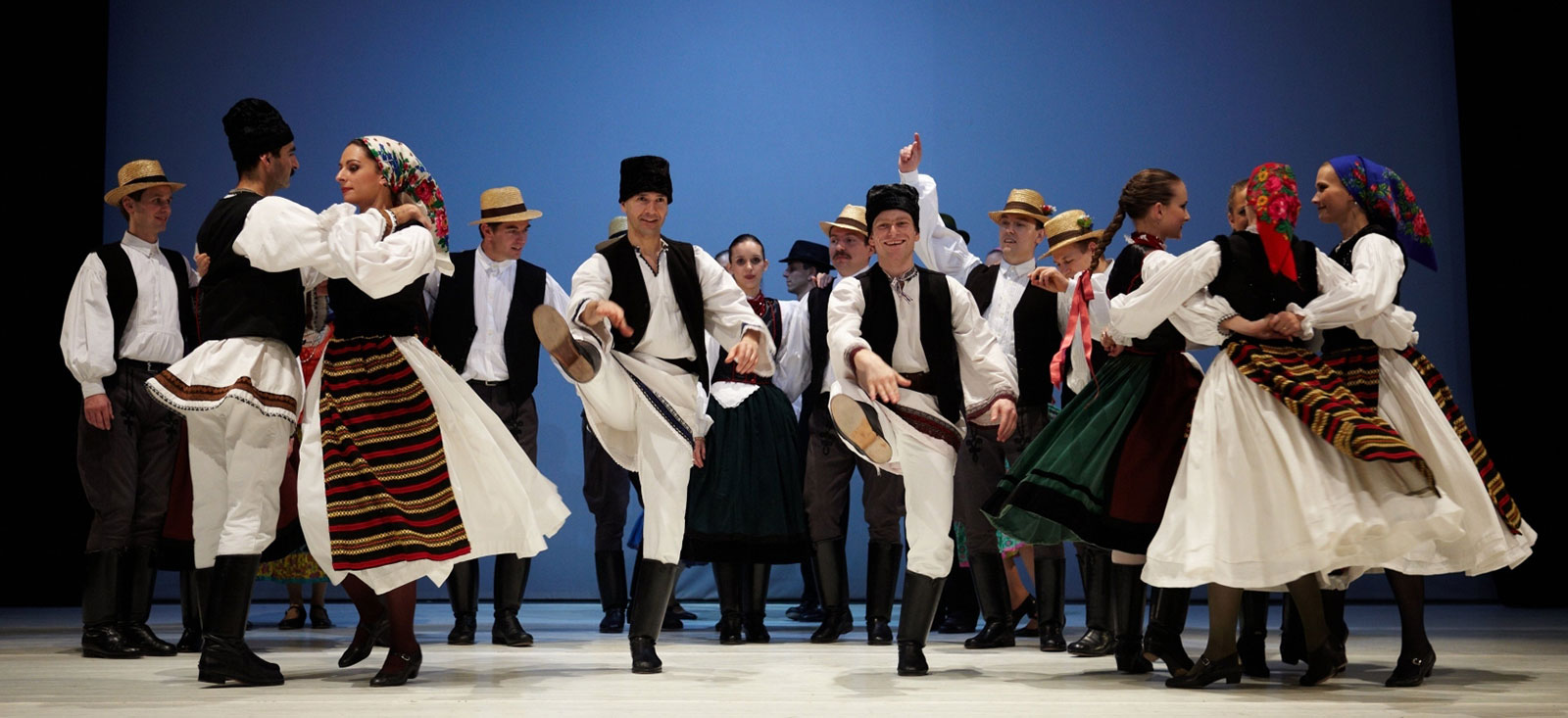
The peacock dance is a slow back and forth that distracts its onlookers while political maneuvering occurs under the folds of its elaborate costume. The steps are mundane, like free parking in Budapest. Performed as a one-two-step in retaliation against the city for its loud opposition to national policy, such as the 2019 “slave law” requiring employees to work up to four hundred hours of unpaid overtime,[16] the peacock dance flatters some (free parking!) but deprives others—Budapest’s municipal government, now without a key source of revenue—tethering them more tightly to the federal government. The dance is an interconnection of parts and the careful repetition of steps; it is the creation of institutions (courts, legislatures, schools, theaters), the protection of private capital, and the grounding of administrative mechanisms. It is deliberate with the pretense of deliberation, a kind of movement that requires restraint and control of one’s limbs. It requires mixing emotion with rational calculation, which is a lesson learned from Max Weber: politics as the “slow, powerful drilling through hard boards, with a mixture of passion and a sense of proportion.”[17] The peacock dance shows Orbán’s illiberalism not as the negation of Western liberalism, but as the positive—active—redirection of the liberal playbook: a variation on a theme familiar to Oxford presidents and philosophers.[18]
The peacock dance is a play on the “end of history”, another variation on a liberal theme. It is, as Orbán explained, a collecting of evidence and building of facts that points to his version of the body politic as inevitable, incontrovertible. “I believe that it would be advantageous in several ways to consider the regime change a completed historical process,” he noted, “the factbook of experience, and not the starting point when thinking about the future, because—if I get it right—our task every year is to try to somehow understand mutually what is happening around us, to grab its essential movements, and maybe see what is going to happen to us in the future.” Yet history has not ended insofar as Orbán’s legislative tinkering and institutional transformation continues. What is happening around us? The construction of power, authority, hierarchy. Through movement—and the movement of bodies—these become natural, essential for the collective and the individual. “Disciplinary power has as its correlative an individuality that is not only analytical and ‘cellular,’ but also natural and ‘organic.’”19
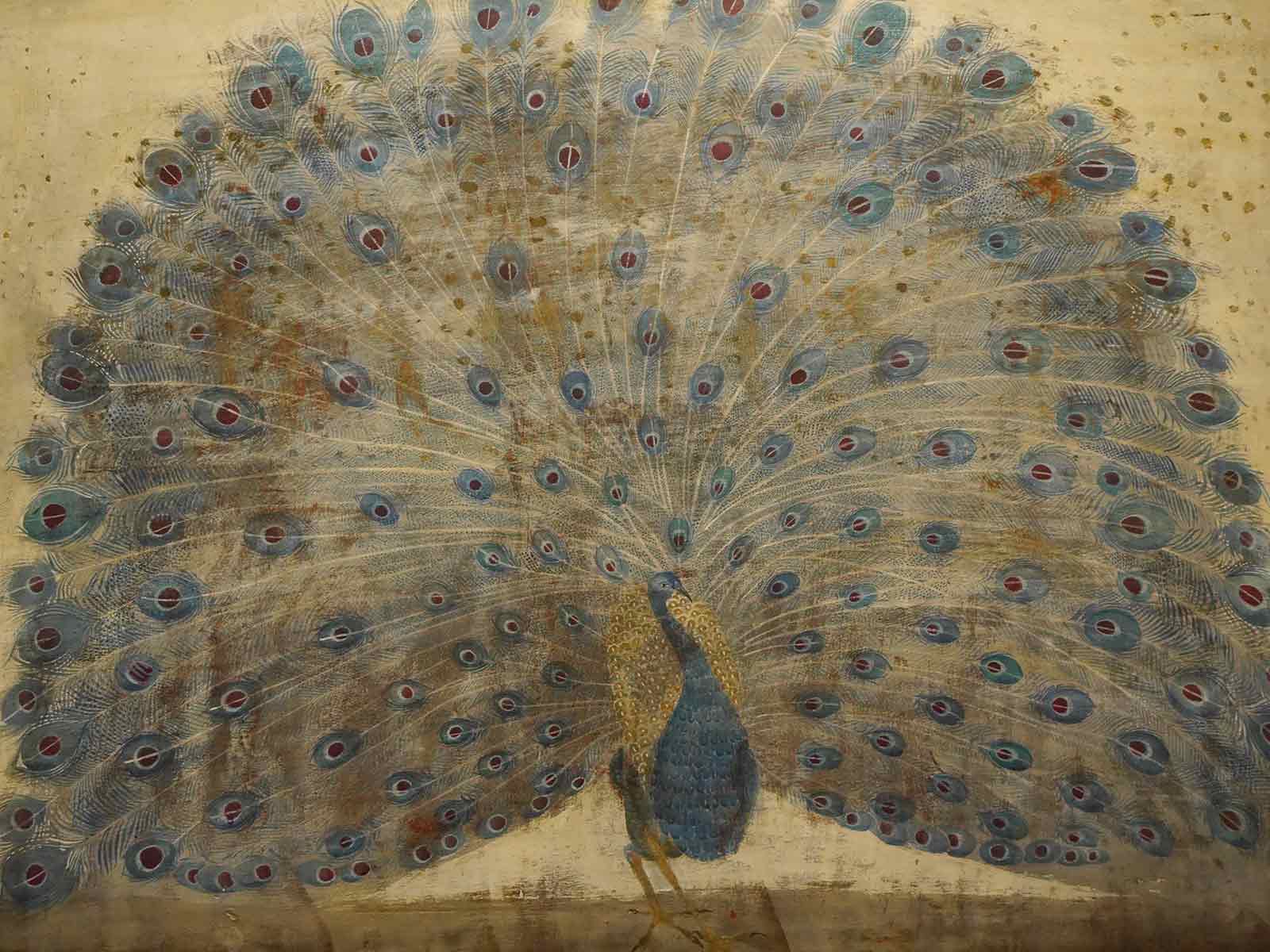
How does Orbán capture these essential movements? The peacock dance combines detached irony with deadly seriousness, transforming politics into a matter of life and death. It begins as mocking humor, a shifting of positions and perspectives, which is a liberal value. And then, it becomes as sober as a sharp jeté, or earnest as an emotive flair. Lacking hesitation, full of confidence, it shows its insides and outsides—its inner feeling and bodily action—as one. Politics, through dancing, has become a display of identity-as-Truth: an illiberal position. And like his anti-liberal predecessors, Orbán “offends against one of the deepest premises of liberalism: politics is necessary but should not become too serious.”[20] Under Orbán, politics is a question of taking sides, which really asks you: What will you die for?
Performed as a duet with a peacock, Kovács’s leap reveals the FT’s motto, “without fear or favor,” as an anti-liberal slogan. With face muzzled, hands gloved like an assassin, the dancer is a menacing figure. Which master does he serve? Who is the head of state to which his body belongs? Defying gravity, Kovács moves with tightly controlled abandon, as if his life counted on it.
• • •
Politics, like dance, naturalizes what is not natural. It does this because politics requires the construction of bodies, material and symbolic. Politics, like dance, is an art because these bodies are both “artistic” and “artificial”; they are invented and imitative, doing the work of invention and imitation at the same time. Politics requires that these bodies learn to move, which is the admission of their incompleteness and their “unnatural” status. Yet the longer they move, the more natural they seem, and the easier it is to forget that they were made in the first place.
Modern politics, like modern art, begins with the acknowledgment of the slippage between these two registers, the natural and unnatural, the inventive and the imitative.[21] Hobbes insisted on the artificiality of the state and the power arrangements instituted between men. Movement, he argued, is essential, natural. Bodies are not. They reveal us as makers. We build them, train them, teach them to do things, often by imitating others. We learn, over time and through the repetition of steps, to control and master them. We swap our heads for other heads, totter a bit, and learn to balance underneath them. What is natural about that? Nature produces motion and movement, but the bodies that string them together into deliberate sequences called “dance” are the source for alteration and improvement.
In 1916, Hungarian Marxist Georg Lukács described life under industrial capitalism as a kind of alienation or “second nature.” For him, this “estrangement from nature (the first nature),” manifests itself in “the modern sentimental attitude to nature, [which] is only a projection of man’s experience of his self-made environment as a prison instead of as a parental home.”[22] Lukács wasn’t the first to use the term; Hegel, Burke, Mill, Marx had all used it before him. Though in different ways, they all used it to refer to something—generally habit, culture, or modes of thought—that seems or feels natural but isn’t. For Lukács, and many of those influenced by him, second nature constituted the “passive, contemplative politics which accepted the world as finished reality,”[23] which, in the mid-twentieth century, made possible the domination of nature taken to nightmarish extremes.
Dancers also refer to their second nature, though unlike Lukács they use it in a positive sense. For them, it is the virtuosic performance of movement by a body that has been trained, taught, and improved upon: artifice made seamless. Second nature is the experience of rehearsing something so many times that deliberate action becomes natural reflex; it is a moment free of self-consciousness, when the body in motion joins harmoniously with a totality of action onstage. The individual, elevated and ennobled, is “lost” to the dance. It is the assertion or revelation of a latent knowledge within one’s self-made body, which is released through the repetition of controlled physical actions. Second nature is the deepening of one’s first nature through the collapse of invention and imitation. Framed within a history of politics, this is self-mastery made pleasurable, exhilarating, liberating.
Orbán’s announcement that his emergency powers will end on June 20—and the 250 pages of legislation accompanying it—is not an “optical illusion” [24] but rather the newest step in his peacock dance. Through its seamless blurring of inventive maneuver and imitative appropriation, the peacock makes its body as it moves. It is a second nature that looks more like dance and less like the history of political thought. Orbán’s transformation of the courts was a dance that, through repetition and rehearsal, gave shape to a new body, which is an administrative court of loyalist judges on which sits Orbán’s executive, growing larger all the time. It is the liberal display of its own self-made power, free, autonomous, self-possessed. At the same time, it is anti-liberal: the slow strengthening of muscle, of an outsized head on a puny, powerless body. Fueled by resentment, the peacock dance disorients to establish its body politic as a fixed truth for which the individual must always be willing to die. It begins with a liberal body, and, collapsing imitation and invention, reinvents it as history, providence, the world.
Watching the dance, what is the history of politics that you see? What will be the one you choose to tell? One of these histories begins not with a king, but with a child, whose role it is to ask questions. The child, who knows no distinction between imitation and invention, wonders how bodies come to be. Not yet masters of themselves, children envision their bodies as an assemblage of mismatched parts: tiny heads sutured to wide torsos, bellybuttons floating up towards eyes, limbs pinned without joints. Their own movements are jarring and unpredictable. Their first steps are off-balance and zombie-like. Watching adults move around them, the child doesn’t wonder: what is this marvelous dance and how can I do it? Instead, they point to the thing and ask: why is that head on this body?

- Ernst Kantorowicz, The King’s Two Bodies: A Study in Medieval Political Theology (Princeton, NJ: Princeton University Press, 2016), 209.
- For Markus J. Buehler’s composition, see soundcloud.com/user-275864738/viral-counterpoint-of-the-coronavirus-spike-protein-2019-ncov.
- See broadwayworld.com/bwwdance/article/Dancer-Performs-to-Melody-Modeling-the-Structure-of-the-Virus-to-Mark-International-Dance-Day-20200429.
- Jan Werner-Müller, “The Hungarian Tragedy,” Dissent (Spring 2011), p. 7.
- Liz Alderman and Marc Santora, “Hungary’s Nationalist Policies Have Created a Labor Shortage. The Fix Isn’t Helping,” The New York Times, 3 May 2019, Available at nytimes.com/2019/05/03/business/hungary-slave-law.html.
- See budapestbeacon.com/full-text-of-viktor-orbans-speech-at-baile-tusnad-tusnadfurdo-of-26-july-2014/.
- Ibid.
- Among them jacobinmag.com/2019/07/viktor-orban-fidesz-party-youth-activism.
- Jan Werner-Müller, “The Hungarian Tragedy,” p. 6.
- See youtube.com/watch?v=4YybjROUMu0.
- See direkt36.hu/en/igy-folyik-tovabb-a-kozpenz-meszaros-lorinctol-az-orban-csaladhoz/
- Zselyke Csaky, “The End of Viktor Orban’s Peacock Dance,” Foreign Policy, 14 September, 2018. Available at
- Jan Werner-Müller, “If You’re Not a Democracy, You’re Not European Anymore,” Foreign Policy, 22 December 2017, p. 2.
- See venice.coe.int/newsletter/newsletter_2012_02/1_hun_en.html.
- Patrick Kingsley, “After Viktor Orban’s Victory, Hungary’s Judges Start to Tumble,” The New York Times, 1 May 2018. Available at nytimes.com/2018/05/01/world/europe/hungary-viktor-orban-judges.html.
- See hungarytoday.hu/coronavirus-free-public-parking-drivers-loss-local-governments/ .
- Max Weber, “Politics as Vocation,” in The Vocation Lectures, ed. David Owen and Tracy Strong, trans. Rodney Livingstone (Chicago: Hackett Books, 2004), p. 93.
- Isaiah Berlin, “Two Concepts of Liberty,” in Liberty, ed. Henry Hardy (Oxford: Oxford University Press, 2003), pp. 166–217.
- Michel Foucault, Discipline and Punish, 2nd ed., trans. Alan Sheridan (New York: Vintage Books, 1997), p. 156.
- Tracy B. Strong, “Foreword,” in Carl Schmitt, The Concept of the Political (Chicago: University of Chicago, 2007), p. xxvi.
- Hans Blumenberg and Anna Wertz, “Imitation of Nature: Toward a Prehistory of the Idea of the Creative Being,” Qui Parle, vol. 12, no. 1 (Spring–Summer 2000), pp. 17–18.
- Georg Lukács, The Theory of the Novel: A Historico-Philosophical Essay on the Forms of Great Epic Literature, trans. Anna Bostock (Cambridge, MA: The MIT Press, 1971), p. 64.
- Martin Jay, Adorno (Cambridge, MA: Harvard University Press, 1984), p. 58.
- See euronews.com/2020/05/28/coronavirus-hungary-bid-to-end-emergency-powers-an-optical-illusion-say-human-rights-ngos.
Ana Isabel Keilson teaches the history of political and social thought at Harvard University.
Spotted an error? Email us at corrections at cabinetmagazine dot org.
If you’ve enjoyed the free articles that we offer on our site, please consider subscribing to our nonprofit magazine. You get twelve online issues and unlimited access to all our archives.